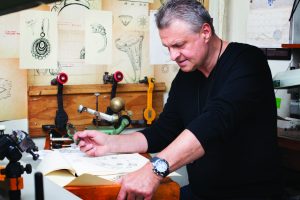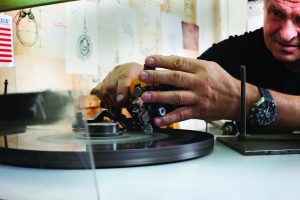By Jennifer Heebner
Christopher Slowinski, the designer behind Christopher Designs, is also the inventor and patent holder of several diamond cuts, most notably Crisscut and L’Amour Crisscut! How did his talent for merging technical precision with artistic abilities originate? According to Slowinski, “It’s a mix of what I was fortunate enough to be born with combined with my educational background.”
Although Slowinski had always excelled naturally in art, when he left Poland in 1976 at age 24, he was well on his way to completing a degree in engineering. Eager to settle in the U.S., he moved to New York and took a job in the Diamond District. It was there that he met his future wife, Ewa, who saw his proclivity for precision and mechanics and encouraged him to pursue the more lucrative path of diamond setting. He took to it quickly, tackling seemingly impossible jobs. “Maybe because of inexperience I didn’t realize what other setters didn’t want to work on,” Slowinski says with a laugh. “I wasn’t afraid to try.” His reputation grew, and he started to pick up numerous setting jobs—so many that he and Ewa opened Christopher Designs in 1981.
His engineering background came in handy when he was presented with a messily made, hand-fabricated ring with invisible-set diamonds, some of which were missing. It was the first invisible setting that Christopher had seen, and he was fascinated with the construction, studying it meticulously to see how it could be reengineered. He determined that if he could reprogram some milling and lathing machines to eliminate the unsteadiness of human hands, he could remake it. It took him almost a month, testing his patience, but he claims that it’s because of that ring that he is in business today.
Another difficult job involved cutting a baguette (step-cut) diamond. Christopher accidentally cut a triangular facet into one of the pavilion facets. Frustrated, he flipped the diamond over to see the damage. When he did, he was surprised at the uncommon beauty and wondered, “What would happen if I did the same thing to all the pavilion and crown facets?” In that moment his engineering mindset sparked creation of the Crisscut diamond. “It was a fortunate mistake, giving the stone more scintillation,” he says of the look, for which he secured a patent in 1998.
More ingenuity came in 2014, when he was trying to bring a wider and shallower piece of diamond rough to life. He realized that leaving larger polished facets on the bottom would act as mirrors, reflecting the more-intricate top faceting. This not only brightened and whitened the diamond but also kept the broader silhouette intact, giving the look of a diamond 50 percent larger. Hence, the birth of L’Amour Crisscut and a new utility patent.
“It’s a revolutionary and different way of cutting diamonds to get maximum brilliance and the look of size, without the extra weight. People don’t realize that they pay for all that weight that’s hidden beneath the setting,” he explains.
As for his patent tally, he stopped counting at 25. “I think I have enough,” he jokes.



